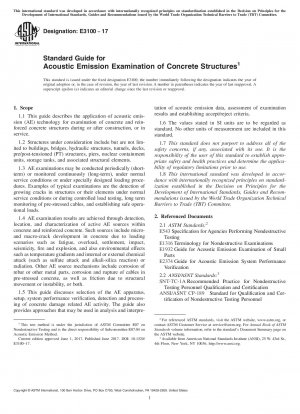ASTM E3100-17
Standard Guide for Acoustic Emission Examination of Concrete Structures
- Standard No.
- ASTM E3100-17
- Release Date
- 2017
- Published By
- American Society for Testing and Materials (ASTM)
- Status
- Replace By
- ASTM E3100-22
- Latest
- ASTM E3100-22
- Scope
-
5.1 Real-time detection and assessment of cracks and other flaws in concrete structures is of great importance. A number of methods have been developed and standardized in recent decades for non-destructive evaluation of concrete structures as well as methods for in-place evaluation of concrete properties. Review of some of these methods can be found in ACI 228.2R-13, ACI 228.1R-03, and ACI 437R-03. They include visual inspection, stress-wave methods such as impact echo, pulse velocity, impulse response, nuclear methods, active and passive infrared thermography, ground-penetrating radar and others. These methods in most of the cases are not used for overall inspection of the concrete structure due to limited accessibility, significant thickness of concrete components, or other reasons and are not applied for continuous long-term monitoring. Further, these methods cannot be utilized for estimation of flaw propagation rate or evaluation of flaw sensitivity to operational level loads or environmental changes, or both.
5.2 In addition to the previously mentioned non-destructive tests methods, vibration, displacement, tilt, shock, strain monitoring, and other methods have been applied to monitor, periodically or continuously, various factors that can affect the integrity of concrete structures during operation. However, these methods monitor risk factors that are not necessarily associated with actual damage accumulation in the monitored structures.
5.3 Monitoring the horizontal (opening) or vertical displacement of existing cracks can be performed as well using different technologies. These may include moving scales (Fig. 1), vibrating wire, draw wire, or other crack opening displacement meters, optical and digital microscopes, strain gages, or visual assessment. However, this type of monitoring is only applicable to surface cracks and requires long monitoring periods.
FIG. 1 Moving Scale Crack Opening Monitor

5.4 This guide is meant to be used for development of acoustic emission applications related to examination and monitoring of concrete and reinforced concrete structures.
5.5 Acoustic emission technology can provide additional information regarding condition of concrete structures compared to the methods described in sections 5.1 – 5.3. For example, the acoustic emission method can be used to detect and monitor internal cracks growing in the concrete, assess crack growth rate as a function of different load or environmental conditions, or to detect concrete micro-cracking due to significant rebar corrosion.
5.6 Accuracy, robustness, and efficiency of AE procedures can be enhanced through the implementation of fundamental principles described in the guide.
1.1 This guide describes the application of aco......
ASTM E3100-17 Referenced Document
- ASTM E1316 Standard Terminology for Nondestructive Examinations
- ASTM E1932 Standard Guide for Acoustic Emission Examination of Small Parts
- ASTM E2374 Standard Guide for Acoustic Emission System Performance Verification
- ASTM E543 Standard Practice for Agencies Performing Nondestructive Testing
- ISO 9712 Non-destructive testing — Qualification and certification of NDT personnel
ASTM E3100-17 history
- 2022 ASTM E3100-22 Standard Guide for Acoustic Emission Examination of Concrete Structures
- 2017 ASTM E3100-17 Standard Guide for Acoustic Emission Examination of Concrete Structures

Copyright ©2024 All Rights Reserved
